| Authors | Title | Published | Journal | PubMed Link |
|---|---|---|---|---|
| pmid: | ||||
| Kasanen JP et al. | Evaluation of sensory irritation of delta3-carene and turpentine, and acceptable levels of monoterpenes in occupational and indoor environment. | 1999 | J. Toxicol. Environ. Health Part A | pmid:10344226 |
| LÃ¥stbom L et al. | Increased airway responsiveness after skin sensitisation to 3-carene, studied in isolated guinea pig lungs. | 2000 | Toxicology | pmid:10924802 |
| Seinfeld JH et al. | Modeling the formation of secondary organic aerosol (SOA). 2. The predicted effects of relative humidity on aerosol formation in the alpha-pinene-, beta-pinene-, sabinene-, delta 3-carene-, and cyclohexene-ozone systems. | 2001 | Environ. Sci. Technol. | pmid:11355196 |
| Warscheid B and Hoffmann T | Structural elucidation of monoterpene oxidation products by ion trap fragmentation using on-line atmospheric pressure chemical ionisation mass spectrometry in the negative ion mode. | 2001 | Rapid Commun. Mass Spectrom. | pmid:11746892 |
| Jin T et al. | [Constituent analysis of the essential oil in leaves of Torreya nucifera]. | 1997 | Zhong Yao Cai | pmid:12572512 |
| PREMA BR and BHATTACHRYYA PK | Microbiological transformations of terpenes. III. Transformations of some mono- and sesqui-terpenes. | 1962 | Appl Microbiol | pmid:13986020 |
| HELLERSTROM S et al. | On the nature of the eczematogenic component of oxidized delta 3-carene. | 1955 | J. Invest. Dermatol. | pmid:14354283 |
| LÃ¥stbom L et al. | Increased airway responsiveness of a common fragrance component, 3-carene, after skin sensitisation--a study in isolated guinea pig lungs. | 2003 | Toxicol. Lett. | pmid:14581172 |
| Reiling KK et al. | Mono and diterpene production in Escherichia coli. | 2004 | Biotechnol. Bioeng. | pmid:15236249 |
| Birkett MA et al. | Responses of female orange wheat Blossom midge, Sitodiplosis mosellana, to wheat panicle volatiles. | 2004 | J. Chem. Ecol. | pmid:15503522 |
| Pommer L et al. | An experimental comparison of a kinetic model for the reaction of alpha-pinene and Delta(3)-carene with ozone and nitrogen oxides. | 2004 | Indoor Air | pmid:15663462 |
| Miyazawa M and Yamafuji C | Inhibition of acetylcholinesterase activity by bicyclic monoterpenoids. | 2005 | J. Agric. Food Chem. | pmid:15740071 |
| Dalton CN et al. | Continuous real-time analysis of products from the reaction of some monoterpenes with ozone using atmospheric sampling glow discharge ionization coupled to a quadrupole ion trap mass spectrometer. | 2005 | Anal. Chem. | pmid:15889904 |
| Røstelien T et al. | Olfactory receptor neurons in two Heliothine moth species responding selectively to aliphatic green leaf volatiles, aromatic compounds, monoterpenes and sesquiterpenes of plant origin. | 2005 | Chem. Senses | pmid:15917371 |
| Docherty KS et al. | Contributions of organic peroxides to secondary aerosol formed from reactions of monoterpenes with O3. | 2005 | Environ. Sci. Technol. | pmid:15984782 |
| Cavaleiro C et al. | Antifungal activity of Juniperus essential oils against dermatophyte, Aspergillus and Candida strains. | 2006 | J. Appl. Microbiol. | pmid:16696681 |
| Yang XW et al. | [GC-MS analysis of essential oils from Radix Angelicae Pubescentis]. | 2006 | Zhongguo Zhong Yao Za Zhi | pmid:16830826 |
| Jeong JG et al. | Low concentration of 3-carene stimulates the differentiation of mouse osteoblastic MC3T3-E1 subclone 4 cells. | 2008 | Phytother Res | pmid:17685387 |
| Woodward S et al. | Physical and chemical responses of Sitka spruce (Picea sitchensis) clones to colonization by Heterobasidion annosum as potential markers for relative host susceptibility. | 2007 | Tree Physiol. | pmid:17938101 |
(+)-3-Carene
(+)-3-carene is a lipid of Prenol Lipids (PR) class.
